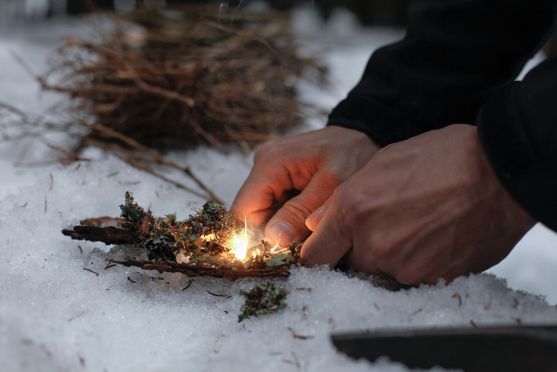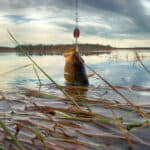Finding yourself in the wilderness without your fishing gear can seem like a tough spot when you’re relying on catching fish to survive. These situations call for innovative survival fishing techniques, which have been used effectively for thousands of years.
Our guide will unveil multiple time-tested methods that allow you to catch fish using minimal resources and ingenuity. Dive in to discover life-saving fishing hacks!
Table of Contents
- Comparison Table of Survival Fishing Techniques
- Hand Fishing: An Age-Old Survival Technique
- Creating a Makeshift Fishing Hook
- Fabricating a Fishing Line from Natural Materials
- Catching Fish with an Improvised Net
- Spearfishing: A Primitive Technique
- Utilizing Fish-Stupefying Plants and Poisons
- Woven Basket Trap: The Art of Ancient Fishing
- Crafting a Fishing Rod from Sticks and Twine
- Tidal Fish Trapping: Nature’s Fish Catcher
- The Use of a Gill Net in Survival Situations
- The Dip Net Technique
- Gorge Hooks: A Primitive Hook Alternative
- Using a Fish Spear for Larger Catches
- Cornering Fish: A Quick and Efficient Technique
- Using a Tarp as a Makeshift Fishing Net
- Turning a Water Bottle into a Fish Trap
- Hand Line Fishing: The Simplicity of Survival Fishing
- Striking Iron: An Alternative Fishing Method
- Conclusion
- What Survival Gear Can I Use to Help with Fishing Without Gear?
- FAQs
- What are some effective survival fishing techniques when you have no gear?
- How can you make a fishing hook without conventional materials?
- Is it possible to catch fish with an improvised net? How?
- Can you explain spearfishing with a sharpened stick?
- What innovative methods can be used to trap fish in survival situations?
Key Takeaways
- You can catch fish using hand fishing or noodling by feeling for them under rocks and riverbanks in shallow waters.
- Improvise fishing hooks from materials like paperclips, safety pins, or natural items such as thorns and carve gorge hooks from wood to attach to lines made from plant fibers or clothing threads.
- Create your own net with durable plant fibers or repurposed fabrics. Sweep the net in the water to catch multiple fish at once.
- Use sharpened sticks as spears for spearfishing in clear, calm water; remember light refraction makes fish look higher than they are so aim lower.
- Fabricate traps such as woven basket traps placed strategically in rivers or tidal fish traps that utilize changing water levels to capture many fish.
Comparison Table of Survival Fishing Techniques
| Technique | Effectiveness | Difficulty Level | Best Use Scenarios |
|---|---|---|---|
| Hand Fishing / Noodling | High in shallow waters | Moderate | Shallow rivers, streams, and lake edges |
| Makeshift Fishing Hook | Moderate | Moderate | Any water body |
| Fishing Line from Natural Materials | Moderate | Moderate | Any water body |
| Improvised Net | High in calm waters | Moderate | Shallow, calm waters |
| Spearfishing | High for larger fish | High | Shallow, clear waters |
| Fish-Stupefying Plants/Poisons | High | Moderate | Any water body |
| Woven Basket Trap | High in calm waters | Moderate | Shallow, calm waters |
| Fishing Rod from Sticks and Twine | Moderate | Moderate | Any water body |
| Tidal Fish Trapping | High in tidal areas | Moderate | Tidal areas |
| Gill Net | High in calm waters | Moderate | Calm, shallow waters |
| Dip Net | High in calm waters | Moderate | Shallow, calm waters |
| Gorge Hooks | Moderate | Moderate | Any water body |
| Fish Spear for Larger Catches | High for larger fish | High | Shallow, clear waters |
| Cornering Fish | High in shallow waters | Moderate | Shallow, calm waters |
| Tarp as Makeshift Net | High in calm waters | Moderate | Shallow, calm waters |
| Water Bottle Fish Trap | Moderate | Low | Any water body |
| Hand Line Fishing | Moderate | Low | Any water body |
| Striking Iron | Moderate | Moderate | Any water body |
No products found.
Hand Fishing: An Age-Old Survival Technique
Hand fishing, also known as noodling, is a technique that has stood the test of time. It requires patience, skillful maneuvers, and an intimate knowledge of aquatic environments to be successful.
Enthusiasts wade into shallow waters and explore under rock ledges or inside riverbanks to locate fish by feel. Once they detect a fish, usually a catfish, in this manner, they use their bare hands to coax it out from its hiding place and capture it.
This method demands quick reflexes and can be quite exhilarating as the catch is literally at your fingertips. Traditionally used by indigenous peoples for sustenance, hand fishing continues to offer modern wilderness survivalists a way to procure food without the need for fishing lines or hooks.
Thriving on minimal equipment and relying heavily on human senses, hand fishing is not just a survival technique but also an art form that links us back to our ancestral roots in nature’s embrace.
Creating a Makeshift Fishing Hook
Moving from the bare-handed challenges of hand fishing, let’s focus on an equally resourceful skill: creating a makeshift fishing hook. Survival situations call for ingenuity, and fashioning a functional hook is a key element in securing your next meal.
- Search for common items that can be repurposed as hooks, such as paperclips, safety pins, or even pieces of wire. Bend these materials into a curved shape similar to a traditional hook.
- Look for natural substitutes like thorns, strong twigs, or animal bones with pointed ends. These can also be shaped into hooks by sharpening them against rocks.
- Broken pop-tops from soda cans are often discarded but make excellent improvised hooks; simply twist off the smaller loop to create the barb.
- If you can access plastic, such as from bottles or packaging, small sharp shards can be heated over a flame and bent into hook shapes.
- Use your multi-tool or knife to carve gorge hooks from wood or bone. A gorge hook is straight, with both ends sharpened, and lies across the bait rather than dangling below it.
- Secure your makeshift hook by tying it firmly to your improvised fishing line. This line could be made from shoelaces, unraveled threads from garments, or natural fibers found in the environment, such as long grasses or inner bark strands.
- Ensure that whatever material you use to craft your homemade hook is strong and sharp enough to pierce through fish lips and hold on without breaking.
Fabricating a Fishing Line from Natural Materials
Having crafted your makeshift hook, the next step is to create a sturdy fishing line. You’ll need to look for strong natural materials that can hold up to the weight and struggle of a caught fish.
- Begin by searching for long, fibrous plants like nettles or yucca, which are known for their strength when twisted into cords.
- Harvest these plant fibers by carefully stripping them from the stem or leaves using your fingernails or a sharp stone.
- Twist or braid multiple strands together to increase the tensile strength of your improvised line, ensuring it won’t snap easily.
- If available, use thin strips of rawhide or animal sinew; when dried, these materials become incredibly strong and flexible.
- When plants are scarce, resort to unraveled pieces of clothing such as shoelaces, sock tops, or frayed fabric edges.
- Securely tie together shorter lengths if you can’t find long continuous strands; just make sure the knots are tight and compact.
- Test your line’s durability by pulling it against a tree branch or similar resistance; this ensures it can withstand the pull of a fish.
Catching Fish with an Improvised Net
After exploring how to fabricate a fishing line using natural materials, let’s shift our focus to crafting an improvised net. This reliable method often yields a good catch and can be created with minimal resources. Here’s how you can fashion your own net to secure fish in a survival setting:
- Scout for suitable materials: Look around for any long, durable plant fibers or vines that can be twisted and braided into cords. If available, repurpose fabric from items you might have on hand, like clothing or bags.
- Weave your net: Start by tying knots along a main cord at regular intervals to serve as anchors for the rest of the net. Then, loop additional fiber lengths in and out of these anchor points to begin forming the mesh.
- Strengthen the edges: Once the basic shape is constructed, reinforce the perimeter by weaving extra layers or incorporating sturdier materials like sticks or twine along the outermost loops.
- Create handheld loops: Secure larger loops at each end of your net’s top edge for your hands. This will help you manage and control your net with greater ease during use.
- Test the mesh size: Ensure that the holes between knots are small enough to trap fish but large enough to allow water flow. Adjust as necessary before heading out to use it.
- Select an ideal fishing spot: Aim for shallow waters where fish congregate, such as riverbanks or lake edges. Calmer waters make it easier to handle the net effectively.
- Master your technique: Sweep your net through the water in a smooth, steady motion. Quickly lift it when you feel resistance, indicating a catch.
Spearfishing: A Primitive Technique
Spearfishing dates back to ancient times, requiring only a sharpened stick and some stealth in the water; this method taps into raw human skill and patience as you become part of the aquatic world, seeking your next meal beneath the surface.
It’s a technique that proves simplicity can still be highly effective for survival fishing in modern times.
Using a Sharpened Stick
Using a sharpened stick for survival, fishing taps into ancient wisdom and skill. It’s a method perfected by generations to catch fish efficiently without modern gear.
- Select a straight, sturdy branch: Look for a branch that’s about arm’s length and as thick as your thumb.
- Sharpen one end to a point: Use a knife or rock to carefully carve the tip into a sharp point suitable for piercing fish.
- Find the right location: Scout for calm, clear water where fish are visible and within reach of your spearfishing attempt.
- Stay silent and still: Approach your fishing spot with minimal noise to avoid scaring away potential catches.
- Aim carefully: Target fish from above, aligning the spear with precision to compensate for light refraction in the water.
- Thrust quickly: Drive the spear into the water with speed and determination to impale the fish on the stick’s pointed end.
- Practice patience: Spearfishing requires time to master, so don’t get discouraged if success isn’t immediate.
- Ensure safety first: Always be mindful of your surroundings and cautious when entering water bodies; never compromise on personal safety.
- Cook your catch thoroughly: After successfully catching a fish, make sure you cook it well to avoid any health risks associated with undercooked seafood.
The Art and Patience of Spearfishing
After fashioneding a sharpened stick, the next step is mastering spearfishing, a practice steeped in tradition and requiring considerable skill. Spearfishing isn’t just about precision; it’s also an exercise in patience.
The water refracts light, distorting your perception, so understanding this optical illusion is crucial for accurate strikes. Fishermen through the ages have honed the delicate art of waiting motionless by the water’s edge or wading silently into shallow streams to outwit their aquatic prey.
Perfecting your technique involves learning how to move without startling fish and identifying the right moment to thrust the spear. The successful spearfisherman must anticipate a fish’s movements while adjusting for refraction under the surface of the water.
It takes time and persistence but catching your meal with nothing more than a homemade spear can be incredibly rewarding. Always remember that safety comes first—ensure you’re aware of local regulations to avoid fishing without a license or targeting endangered species.
Utilizing Fish-Stupefying Plants and Poisons
In survival situations, sometimes you have to think outside the tackle box. That’s where fish stupefying plants and poisons come into play. These natural substances can temporarily paralyze or kill fish, making them easier to catch by hand or with simple tools.
You’ll find these potent plants in various parts of the world; they contain chemicals affecting a fish’s swim ability. Indigenous communities have used this method for centuries, relying on local knowledge of which plants are effective.
Before trying it yourself, be sure you identify the right plants and understand how to use them properly. Crushed plant materials are typically thrown into still pools or streams where target fish congregate.
As the plant toxins dissolve in water, they disrupt the fish’s gill function and often bring them to the surface gasping for air—within reach of a waiting survivor. While powerful, this technique requires respect for nature and awareness of laws regarding its use, as some regions prohibit chemical fishing due to environmental concerns.
Always consider sustainability when employing such methods; our goal is survival without causing undue harm to the ecosystems we depend on.
Woven Basket Trap: The Art of Ancient Fishing
Moving on from the natural fish sedatives, the woven basket trap is another time-honored method that requires patience but no hooks or lines. This fishing technique may be ancient, but it’s still effective today.
Masters of old-fashioned survival skills would intricately weave baskets by hand using readily available materials like reeds, vines, or bamboo. These baskets were designed to let small fish swim in and become trapped as they sought refuge or bait placed inside.
Fishermen would submerge these carefully crafted traps into streams or rivers at strategic locations where fish congregated. The basket’s opening faced upstream, allowing unsuspecting fish to easily glide in with the current.
Once inside, they found exiting difficult due to the narrow funnel-like entrance preventing their escape. Skillfully placing and retrieving these traps meant a reliable food source without constant attention—allowing ancient anglers to multitask while securing their next meal.
Crafting a Fishing Rod from Sticks and Twine
Survival situations require creative solutions, and a handmade fishing rod can be a lifesaver. Twine, shoelaces, or vines can partner perfectly with a sturdy stick to create an effective rod.
- Find a straight branch: For optimal flex and control, look for one that’s about 6 feet long and as thick as your thumb.
- Secure the line: Use twine, shoelaces, or even strong vines by securely tying one end around the stick’s base near the tip.
- Test its strength: Give the line a few tugs to ensure it’s firmly attached and won’t snap when you catch a fish.
- Create your hook: Unbend a paperclip or pop-top into a hook shape. If wire is available, use it for something stronger.
- Attach your hook: Tie it tightly to the free end of your fishing line using whatever is at hand that will hold.
- Consider lure options: To mimic fish prey, you can use anything small and shiny, like bits of metal foil or small fragments from reflective packaging materials.
- Add weight if needed: Small rocks or metal nuts can serve as makeshift sinkers to keep your bait under water; tie these above the hook on the line.
- Keep your eye on movement: Staying alert will help you react quickly once a fish starts nibbling on your bait.
- Practice patience: Fishing takes time, so settle in and prepare for a wait—it might take several tries before you get a bite.
Tidal Fish Trapping: Nature’s Fish Catcher
Moving from the ingenuity of crafting a fishing rod, the focus shifts to tidal fish trapping, an effective strategy that harnesses the power of tides. This ancient method captures fish as they move with the ebb and flow of coastal waters.
It involves constructing barriers in tidal areas like estuaries where water levels fluctuate regularly. As the tide goes out, fish that move into higher areas with the incoming water find themselves trapped behind these barriers or in constructed pools.
Constructing a tidal fish trap requires keen observation of local marine patterns and an understanding of how fish behave in changing tides. Ideal spots for setting up traps include places where water naturally recedes to reveal small pools or channels – prime locations where fish might get caught as water levels lower.
Rocks, stakes, and nets can be arranged strategically to create enclosures that guide unsuspecting fish toward these confined spaces, making capture almost certain once the tide retreats.
With this noninvasive technique, one can harvest multiple catches without significantly disturbing marine ecosystems; thus, it’s seen as nature’s way of offering a bounty to those patient enough to learn its rhythms.
The Use of a Gill Net in Survival Situations
Shifting focus from tidal traps, mastering the gill net can dramatically increase your chances of securing a meal in a survival scenario. Gill nets serve as an efficient fishing method that capitalizes on fish behavior.
Essentially, they work by ensnaring fish through their gills as they try to swim past, hence the name. You set up these nets across waterways where fish are known to pass regularly, especially during seasonal migrations or when funneled into narrow channels.
Constructing and deploying a gill net requires skill but pays off with potentially large hauls of fish without constant monitoring. The size of the mesh will determine which species you catch; smaller openings are for little fish and larger ones are for bigger game.
Position is also key—hung vertically in the water column just right, and you could end up feeding yourself for days on an otherwise deserted shore or wilderness escape. Unlike rod-and-line fishing or spearfishing, once your gill net is properly placed, it does the hard work while you tackle other survival tasks like building a shelter or starting a fire.
The Dip Net Technique
Mastering the dip net technique can greatly increase your chances of survival when traditional fishing gear is not available. This method allows for an effective and efficient way to catch fish, using materials that are often readily accessible in a natural environment.
- Choose a suitable location: Look for calm, shallow waters where fish tend to gather, such as near a riverbank or stream.
- Construct the net frame: Find a Y-shaped branch for stability and attach two straight sticks at the ends to form a hoop.
- Create the netting: Use any available fabric, such as an old t-shirt or leaves woven tightly together, and secure it over the hoop.
- Secure the handle: Tie the Y-shaped branch to an extended pole for reach, ensuring it is strong enough to hold the weight of your catch.
- Bait the area (optional): Attract fish to your chosen location by adding small pieces of bait into the water.
- Submerge the net gently: Slide it into the water without causing too much disturbance that may scare away fish.
- Wait patiently: Hold your net steady and give the fish time to swim over it. Quick reflexes will be crucial at this stage.
- Lift with care: When you sense a fish above the netting, lift up quickly but smoothly to trap and scoop up your catch.
- Keep your haul secure: Transfer captured fish into a container with water or onto land if immediate consumption is planned.
Gorge Hooks: A Primitive Hook Alternative
Gorge hooks offer a simple yet effective way to fish in survival situations. They work well with a minimal and natural setup, making it easy to catch prey without modern gear.
- Start by finding a small, straight piece of bone, hardwood, or thorn to serve as the main body of your gorge hook.
- Sharpen both ends of your chosen material to fine points; this helps ensure the hook lodges firmly in the fish’s mouth.
- Choose bait that is appealing to local fish species; insects, worms, and small pieces of fish can all be effective.
- Attach your bait securely on the gorge hook; you want it to stay put when a fish bites.
- Use patience as you place your gorge hook into the water at a spot frequented by fish; camouflage with surrounding vegetation if possible.
- Connect the gorge hook to a makeshift line from plant fibers or strands from worn clothing.
- Remain alert and watch for any movement or tugging on your line, indicating that a fish has taken the bait.
- Gently pull on the line once you feel a bite; swift movements can dislodge the gorge hook before it’s properly set in the fish’s mouth.
- Understand that timing is crucial—wait for the right moment before pulling to increase your chances of catching the fish.
Using a Fish Spear for Larger Catches
Crafting a fish spear is essential for catching larger fish in a survival situation. A well-made spear can be the difference between going hungry and securing a hearty meal.
- Choose a straight, sturdy branch: Look for a green, live branch that’s about five to six feet long for the best leverage and durability.
- Sharpen one end of the stick: Use a rock or knife to carve the end into a sharp point; this will help you pierce through water and fish effectively.
- Harden the spear tip with fire: Briefly expose the sharpened tip to flames to harden it, making it more durable against the scales and strength of big fish.
- Practice throwing your spear: Aim low and account for light refraction, which makes fish appear higher in water than they actually are.
- Stand very still near the water’s edge: Sudden movements can scare away your potential catch, so patience is key.
- Target shallow waters: Bigger fish often come close to shore during feeding times; use these opportunities to your advantage.
- Aim directly at the middle section of fish: This increases your chances of hitting vital organs and securing your catch quickly.
- Retrieve your spear immediately after throwing: Whether you hit or miss, you must recover your spear fast to prepare for another attempt or else risk losing it.
- Learn from missed attempts: Observe how fish react and adjust your technique accordingly; practice improves precision over time.
Cornering Fish: A Quick and Efficient Technique
Cornering fish is a speedy and effective method to catch them in a survival situation. It involves driving fish into shallow water or a confined space where you can easily capture them.
- Start by scouting for areas where fish might naturally get trapped, such as small pools within rivers or the edges of ponds.
- Use rocks, sticks, or even your feet to create barriers that make these spaces even smaller and prevent the fish from escaping.
- Approach the area slowly so you don’t startle the fish, staying as quiet as possible to avoid detection.
- Work with others if available, forming a line and moving together to herd the fish towards the cornered area.
- Make sure to block off any potential escape routes, paying close attention to gaps in your barrier where fish could slip through.
- Once the fish are cornered, move quickly but deliberately to grab them; wearing gloves can help you keep a firm grip on slippery fish.
- If grabbing with hands isn’t an option, improvise with clothing items like shirts or bandanas to scoop up the fish.
- Stay persistent if your first attempt doesn’t succeed; it may take several tries to trap and secure your catch effectively.
Using a Tarp as a Makeshift Fishing Net
A tarp can be your lifeline in a survival situation, especially when you need to catch fish without traditional gear. Transforming a standard tarp into an effective fishing net is simpler than you might think.
- Find a heavy-duty tarp: Ensure it is durable and has no holes or tears.
- Cut the tarp to size: If necessary, trim it down so that it’s manageable for one or two people to handle.
- Secure weights to one edge: Attach stones or other heavy objects evenly across the lower side of the tarp; these will help sink the net.
- Tie floaters on the opposite edge: Use wood, plastic bottles, or any buoyant materials at hand to keep the top side afloat.
- Position the makeshift net in water: Locate a spot where fish are likely to pass through, such as between two water bodies or in a narrow stream.
- Work with a partner if possible: One person can hold one end while another moves downstream, herding fish toward the net.
- Drag and lift carefully: Slowly pull the weighted end across the bottom and then lift together swiftly to trap and collect fish within.
- Practice proper handling: Quickly but gently retrieve fish from your tarp net to avoid injuring them if catch-and-release is intended.
Turning a Water Bottle into a Fish Trap
Moving from using a tarp as a fishing net, let’s now look at how a common water bottle can become an effective fish trap. This method is practical because of its simplicity and the availability of materials.
- Find a clear plastic water bottle; the transparency will lure fish inside.
- Cut off the top of the bottle right where it starts to narrow towards the cap.
- Invert the top and place it back inside the bottle to create a funnel shape.
- Secure the inverted piece with staples or by punching holes and tying it with string or twine.
- Place bait inside your trap, such as small pieces of bread or worms, to attract fish.
- Add weight to your trap by attaching small rocks or sand so that it sinks to the bottom.
- Choose a spot in the water where you’ve seen fish activity and submerge your trap.
- Check your trap regularly, ideally every few hours, to see if you’ve caught anything.
- Once you catch fish, remove them carefully to avoid damaging both fish and trap for future use.
- Remember that this type of trap works best in calm waters like ponds or slow-moving streams.
Hand Line Fishing: The Simplicity of Survival Fishing
Hand line fishing harnesses the essence of survival techniques, using nothing more than a simple line and bait. Throughout history, people have caught fish with this straightforward method, demonstrating that sophisticated gear isn’t always necessary to secure food.
You can swiftly fashion a hand line by tying a sturdy string or thin rope to a hook crafted from a bent piece of metal or bone. Add something small and shiny as bait, or dig up worms and insects.
Cast your handmade rig into calm waters where fish congregate, such as near logs or rock outcroppings. Be patient, and wait for the tug of a curious fish investigating your bait.
Pull the line steadily when you feel the bite, bringing in your catch hand over hand. Handline fishing connects you with the primal art of catching food and challenges your creativity and resourcefulness while surviving in nature’s vast playground.
Striking Iron: An Alternative Fishing Method
Striking iron may seem like a surprising method for survival fishing, but it’s a technique with roots in ancient practices. Here’s how you can catch fish using tools as simple as a piece of metal and some natural elements.
- Find a suitable piece of iron: This could be any metallic object that can create sparks when struck against a rock or another hard surface.
- Look for the right kind of tinder: Dry moss, bird nests, or any fine, dry vegetation will work to catch the sparks from your striking iron.
- Create a spark-catching platform: Place your tinder on a dry surface near the water’s edge where you’ve spotted fish.
- Strike the iron against flint or quartz: Hold your metal piece at an angle above the tinder and hit it with your chosen rock to generate sparks.
- Use the smoldering tinder to attract fish: Once embers form, they’ll begin to produce smoke, which can attract certain types of curious fish closer to shore.
- Prepare to catch the fish by hand or improvised tool: As the interested fish approach the source of smoke, quickly scoop them up or use an improvised spear.
Conclusion
Mastering the art of survival fishing empowers you to thrive in nature. Each method harnesses resourcefulness and ingenuity, tapping into both ancient wisdom and creative modern twists.
Whether bending twigs for hooks or fashioning nets from vines, success lies in your adaptability. Embrace these techniques; they might just tip the scales in your favor during a wilderness adventure.
Armed with knowledge—and perhaps a little luck—you’re ready to reel in your catch against all odds.
What Survival Gear Can I Use to Help with Fishing Without Gear?
When fishing without gear, it’s crucial to have essential survival gear components for improvising. A knife can double as a makeshift hook, while paracord can be used for fishing line. A metal water bottle can function as a weight for casting. Improvisation is key to survival in such situations.
FAQs
What are some effective survival fishing techniques when you have no gear?
Several inventive methods can be used to achieve survival fishing without traditional gear. Techniques include hand fishing (or noodling), making makeshift hooks from natural or repurposed materials, fabricating fishing lines from plant fibers or threads, spearfishing with sharpened sticks, and creating improvised nets from durable plant fibers or fabric. These methods rely on ingenuity and the effective use of available resources in the wilderness.
How can you make a fishing hook without conventional materials?
Various everyday items or natural resources can be utilized to fashion a makeshift fishing hook. Paperclips, safety pins, or pieces of wire can be bent into hook shapes. Natural substitutes such as thorns, strong twigs, or animal bones can be carved or shaped into hooks. These improvised hooks can then be attached to homemade fishing lines crafted from materials like shoelaces, garment threads, or plant fibers.
Is it possible to catch fish with an improvised net? How?
Yes, you can catch fish using an improvised net crafted from minimal resources. Look for long, durable plant fibers or vines that can be braided into cords or repurposed fabric from clothing or bags. Weave the material to create a net by tying knots along a main cord at regular intervals and looping additional fiber lengths in and out to form the mesh. Use the net in shallow waters, employing a sweeping motion to trap fish.
Can you explain spearfishing with a sharpened stick?
Spearfishing with a sharpened stick is an ancient technique that involves using a straight, sturdy branch sharpened at one end. This method requires patience and stealth, as the fisherman must quietly approach the fishing spot in calm, clear water and thrust the spear with precision to catch fish. Light refraction in water necessitates aiming below the perceived position of the fish for successful spearfishing.
What innovative methods can be used to trap fish in survival situations?
Innovative methods for trapping fish in survival scenarios include incapacitating fish with stupefying plants, constructing woven basket traps, employing tidal fish trapping techniques, and using gill nets. Other creative strategies involve turning a water bottle into a fish trap or using a tarp as a makeshift fishing net. These methods utilize environmental features and available materials to catch fish without conventional gear.
No products found.







Leave a Reply